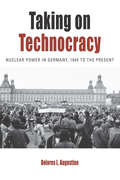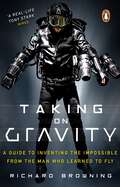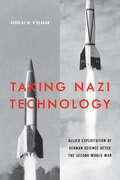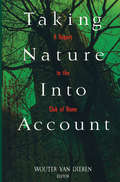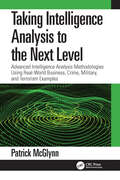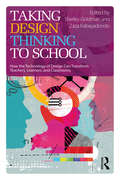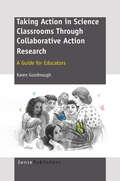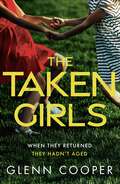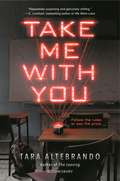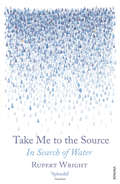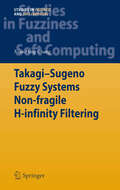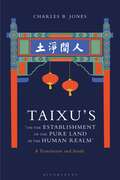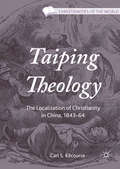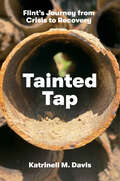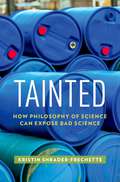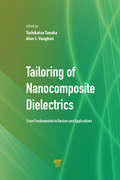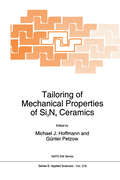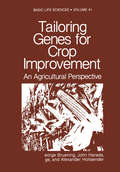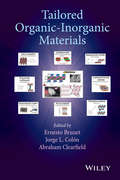- Table View
- List View
Taking on Technocracy: Nuclear Power in Germany, 1945 to the Present (Protest, Culture & Society #24)
by Dolores L. AugustineThe German abandonment of nuclear power represents one of the most successful popular revolts against technocratic thinking in modern times—the triumph of a dynamic social movement, encompassing a broad swath of West Germans as well as East German dissident circles, over political, economic, and scientific elites. Taking on Technocracy gives a brisk account of this dramatic historical moment, showing how the popularization of scientific knowledge fostered new understandings of technological risk. Combining analyses of social history, popular culture, social movement theory, and histories of science and technology, it offers a compelling narrative of a key episode in the recent history of popular resistance.
Taking on Gravity: A Guide to Inventing the Impossible from the Man Who Learned to Fly
by Richard Browning**As seen on Top Gear**For fans of Adrian Newey, Guy Martin and Chris Hadfield, in Taking on Gravity inventor Richard Browning tells the inspiring story behind his iconic jet suit, and shares his creative principles for generating true innovation.From Icarus to Iron Man, the dream of human flight has always inspired and challenged us. Now, with his pioneering jet suit, Richard Browning has redefined what is possible.Richard Browning's story is one of groundbreaking innovation. Building an aviation business from his garage, he has invented a whole new form of personal flight - a fantasy previously reserved for the pages of science fiction. His iconic jet suit has captured the imaginations of millions around the world, triggered ongoing developments in technology and engineering, and inspired a new generation of creative minds to pursue their dreams.In Taking on Gravity, Browning reveals the creative principles of his multimillion-pound company, Gravity Industries, and shows us how grass-roots innovation can disrupt established industries in exciting and unexpected ways. On this journey into the sky we'll experience what it's like to take flight, to test the limits of the human body, and to convert moonshot ideas into tangible results.The Gravity story is an inspiring example of human creativity and our ceaseless desire to push the boundaries of what is possible. Where we go next is up to you.
Taking Nazi Technology: Allied Exploitation of German Science after the Second World War
by Douglas M. O'ReaganDuring the Second World War, German science and technology posed a terrifying threat to the Allied nations. Combined with Germany's generations-old reputation for excellence in science and engineering, these advanced weapons, which included rockets, V-2 missiles, tanks, submarines, and jet airplanes, gave troubling credence to Nazi propaganda about forthcoming "wonder-weapons" that would turn the war decisively in the Axis' favor. After the war ended, the Allied powers raced to seize "intellectual reparations" from almost every field of industrial technology and academic science in occupied Germany. It was likely the largest-scale technology transfer in history.In Taking Nazi Technology, Douglas M. O'Reagan describes how the Western Allies gathered teams of experts to scour defeated Germany, seeking industrial secrets and the technical personnel who could explain them. Swarms of investigators recruited from industry, military branches, and intelligence agencies invaded Germany's factories and research institutions. They seized or copied all kinds of documents, from patent applications to factory production data to science journals. They questioned, hired, and sometimes even kidnapped hundreds of scientists, engineers, and other technical personnel. They studied technologies from aeronautics to audiotapes, toy making to machine tools, chemicals to carpentry equipment. They took over academic libraries, jealously competed over chemists, and schemed to deny the fruits of German invention to any other land—including that of their allies. Drawing on declassified records, O'Reagan looks at which techniques worked for these very different nations, as well as which failed—and why. Most importantly, he shows why securing this technology, how the Allies did and when they did, still matters today. He also argues that these programs did far more than spread German industrial science: they forced businessmen and policymakers around the world to rethink how science and technology fit into diplomacy, business, and society itself. A deeply researched comparative history of the American, British, French, and Soviet efforts to control and exploit German science and technology amid fierce internal and external competition, Taking Nazi Technology is the first history to capture the whole picture of this crucial period at the dawn of the Cold War.
Taking Nazi Technology: Allied Exploitation of German Science after the Second World War
by Douglas M. O'ReaganDuring the Second World War, German science and technology posed a terrifying threat to the Allied nations. Combined with Germany's generations-old reputation for excellence in science and engineering, these advanced weapons, which included rockets, V-2 missiles, tanks, submarines, and jet airplanes, gave troubling credence to Nazi propaganda about forthcoming "wonder-weapons" that would turn the war decisively in the Axis' favor. After the war ended, the Allied powers raced to seize "intellectual reparations" from almost every field of industrial technology and academic science in occupied Germany. It was likely the largest-scale technology transfer in history.In Taking Nazi Technology, Douglas M. O'Reagan describes how the Western Allies gathered teams of experts to scour defeated Germany, seeking industrial secrets and the technical personnel who could explain them. Swarms of investigators recruited from industry, military branches, and intelligence agencies invaded Germany's factories and research institutions. They seized or copied all kinds of documents, from patent applications to factory production data to science journals. They questioned, hired, and sometimes even kidnapped hundreds of scientists, engineers, and other technical personnel. They studied technologies from aeronautics to audiotapes, toy making to machine tools, chemicals to carpentry equipment. They took over academic libraries, jealously competed over chemists, and schemed to deny the fruits of German invention to any other land—including that of their allies. Drawing on declassified records, O'Reagan looks at which techniques worked for these very different nations, as well as which failed—and why. Most importantly, he shows why securing this technology, how the Allies did and when they did, still matters today. He also argues that these programs did far more than spread German industrial science: they forced businessmen and policymakers around the world to rethink how science and technology fit into diplomacy, business, and society itself. A deeply researched comparative history of the American, British, French, and Soviet efforts to control and exploit German science and technology amid fierce internal and external competition, Taking Nazi Technology is the first history to capture the whole picture of this crucial period at the dawn of the Cold War.
Taking Nature Into Account: A Report to the Club of Rome Toward a Sustainable National Income
by Wouter van DierenIndicators used to direct ecomonic policy are based on a number of factors - none of which, however, acknowledge the degradation of natural resources. Continued deterioration of the environment is leading us closer to crisis, while policymakers and the public base their decisions on dangerously incomplete information. In Taking Nature into Account, a number of the world's leading experts state the ethical, historical, economic, and ecological arguments for including environmental factors when measuring fiscal health. Initiated by the Club of Rome (an international group of influential businesspeople, statesmen, and scientists), and written in cooperation with the World Wide Fund for Nature, the report reviews existing methodologies and makes recommendations for adjusting the way we think about and measure the economy.
Taking Intelligence Analysis to the Next Level: Advanced Intelligence Analysis Methodologies Using Real-World Business, Crime, Military, and Terrorism Examples
by Patrick McGlynnTaking Intelligence to the Next Level: Advanced Intelligence Analysis Methodologies Using Real-World Business, Crime, Military, and Terrorism Examples examines intelligence gathering and analysis and the significance of these programs. Coverage assumes a basic understanding of the intelligence cycle and processes, and the book builds upon the author’s previous text, Intelligence Analysis Fundamentals—also published by CRC Press—to further address various types of intelligence, the function and increasing usage of intelligence in both the private and public sectors, and the consumption of intelligence products to inform strategic decision-making. Developed for a classroom environment, chapters are packed with multiple examples, visuals, and practical exercises tailored for the intelligence community (IC), military intelligence analyst, criminal, or business analyst alike. The text begins with a chapter on analytical ethics, an important topic that sets the tone for those to come that cover intelligence gathering analytical techniques. The author utilizes multiple instructive learning approaches to build on the student’s existing analytical skills gained from other training resources, their experience, or some other combination. While topics covered are germane to all intelligence analysis fields—including military, national, political, criminal, and business—specific chapters and sections and most instructional examples, scenarios, exercises, and learning activities focus on the Homeland Security Mission and the associated problem sets. The training presentation methods and instructional approaches are the product of much thought, research, and discussion, and a variety of US government and commercial analytical training methodologies are presented. The book closes with a final chapter looking at future trends in intelligence analysis. Key Features: Provides tools to challenge intelligence assessments systematically and objectively, a prerequisite to vetted intelligence conclusions Outlines diagnostic techniques to explain events or data sets, anticipate potential outcomes, predict future trends, and make decisions for optimal outcomes Details how to conduct research to effectively write, edit, format, and disseminate reports to best effect An accompany Instructor’s Guide, for use in the classroom, contains the same practical exercises as those found in the student text, as well as facilitator’s guides, practical exercise solutions, discussion points, sample test questions, and answer keys, to include other websites that can provide additional instructional content. Taking Intelligence to the Next Level serves as an essential course textbook for programs in intelligence, terrorism, and Homeland Security in additional to serving a useful reference for practiving professionals. Ancillaries including PowerPoint lecture slides, as well as the Instructor’s Guide with Test Bank, are available for qualified course adopters.
Taking Intelligence Analysis to the Next Level: Advanced Intelligence Analysis Methodologies Using Real-World Business, Crime, Military, and Terrorism Examples
by Patrick McGlynnTaking Intelligence to the Next Level: Advanced Intelligence Analysis Methodologies Using Real-World Business, Crime, Military, and Terrorism Examples examines intelligence gathering and analysis and the significance of these programs. Coverage assumes a basic understanding of the intelligence cycle and processes, and the book builds upon the author’s previous text, Intelligence Analysis Fundamentals—also published by CRC Press—to further address various types of intelligence, the function and increasing usage of intelligence in both the private and public sectors, and the consumption of intelligence products to inform strategic decision-making. Developed for a classroom environment, chapters are packed with multiple examples, visuals, and practical exercises tailored for the intelligence community (IC), military intelligence analyst, criminal, or business analyst alike. The text begins with a chapter on analytical ethics, an important topic that sets the tone for those to come that cover intelligence gathering analytical techniques. The author utilizes multiple instructive learning approaches to build on the student’s existing analytical skills gained from other training resources, their experience, or some other combination. While topics covered are germane to all intelligence analysis fields—including military, national, political, criminal, and business—specific chapters and sections and most instructional examples, scenarios, exercises, and learning activities focus on the Homeland Security Mission and the associated problem sets. The training presentation methods and instructional approaches are the product of much thought, research, and discussion, and a variety of US government and commercial analytical training methodologies are presented. The book closes with a final chapter looking at future trends in intelligence analysis. Key Features: Provides tools to challenge intelligence assessments systematically and objectively, a prerequisite to vetted intelligence conclusions Outlines diagnostic techniques to explain events or data sets, anticipate potential outcomes, predict future trends, and make decisions for optimal outcomes Details how to conduct research to effectively write, edit, format, and disseminate reports to best effect An accompany Instructor’s Guide, for use in the classroom, contains the same practical exercises as those found in the student text, as well as facilitator’s guides, practical exercise solutions, discussion points, sample test questions, and answer keys, to include other websites that can provide additional instructional content. Taking Intelligence to the Next Level serves as an essential course textbook for programs in intelligence, terrorism, and Homeland Security in additional to serving a useful reference for practiving professionals. Ancillaries including PowerPoint lecture slides, as well as the Instructor’s Guide with Test Bank, are available for qualified course adopters.
Taking Design Thinking to School: How the Technology of Design Can Transform Teachers, Learners, and Classrooms
by Shelley Goldman Zaza KabayadondoDesign thinking is a method of problem-solving that relies on a complex set of skills, processes and mindsets that help people generate novel solutions to problems. Taking Design Thinking to School: How the Technology of Design Can Transform Teachers, Learners, and Classrooms uses an action-oriented approach to reframing K-12 teaching and learning, examining interventions that open up dialogue about when and where learning, growth, and empowerment can be triggered. While design thinking projects make engineering, design, and technology fluency more tangible and personal for a broad range of young learners, their embrace of ambiguity and failure as growth opportunities often clash with institutional values and structures. Through a series of in-depth case studies that honor and explore such tensions, the authors demonstrate that design thinking provides students with the agency and compassion that is necessary for doing creative and collaborative work, both in and out of the classroom. A vital resource for education researchers, practitioners, and policymakers, Taking Design Thinking to School brings together some of the most innovative work in design pedagogy.
Taking Design Thinking to School: How the Technology of Design Can Transform Teachers, Learners, and Classrooms
by Shelley Goldman Zaza KabayadondoDesign thinking is a method of problem-solving that relies on a complex set of skills, processes and mindsets that help people generate novel solutions to problems. Taking Design Thinking to School: How the Technology of Design Can Transform Teachers, Learners, and Classrooms uses an action-oriented approach to reframing K-12 teaching and learning, examining interventions that open up dialogue about when and where learning, growth, and empowerment can be triggered. While design thinking projects make engineering, design, and technology fluency more tangible and personal for a broad range of young learners, their embrace of ambiguity and failure as growth opportunities often clash with institutional values and structures. Through a series of in-depth case studies that honor and explore such tensions, the authors demonstrate that design thinking provides students with the agency and compassion that is necessary for doing creative and collaborative work, both in and out of the classroom. A vital resource for education researchers, practitioners, and policymakers, Taking Design Thinking to School brings together some of the most innovative work in design pedagogy.
TAKING ACTION IN SCIENCE CLASSROOMS THROUGH COLLABORATIVE ACTION RESEARCH: A Guide For Educators
by Karen GoodnoughThis book provides an introduction to the nature of collaborative action research, explains how to engage in the action research process, and offers readers insights into how collaborative action research may be embedded in everyday classroom practice. The latter objective will be accomplished by engaging the reader with four case studies about teachers who took part in collaborative action research. Each case study focuses on teacher beliefs about science teaching and learning, how school-based teams of teachers develop and implement plans of action in their classrooms, and how action research results in changes teacher learning and classroom practice. This book will be of interest to anyone who wishes to develop an understanding of or engage in collaborative action research, especially practitioners and teacher educators.
The Taken Girls
by Glenn CooperThey were taken. They returned. They never aged. A family is abducted. There are no signs of a struggle. Their Italian holiday villa is untouched. There are no ransom demands. The parents and two little girls, Victoria and Elizabeth, have simply vanished.The daughters are returned. Four years later, the girls appear back at the family's holiday home. But they are the exact same ages they were at the time of their abduction. Their parents are still nowhere to be seen.Only one man can solve the mystery. Marcus Handler, a retired CIA officer, is hired to investigate. He wants Victoria and Elizabeth's disappearance explained. But his hunt for answers leads Marcus to a disturbing truth and a reckoning with his own troubled past...What everyone's saying about Glenn Cooper: 'As Cooper builds the layers of intrigue it becomes clear that he is no ordinary thriller writer, but one who asks big questions' SUNDAY TELEGRAPH'Fast paced and original, Cooper delivers' SUN'Outstanding style and tense, gripping storylines' EUROCRIME'Dynamic, inspirational... You will not be disappointed' FRESH FICTION'Incandescent and explosive' JAMES ROLLINS
Take Me with You
by Tara Altebrando"Repeatedly surprising and genuinely chilling." - E. Lockhart, bestselling author of We Were Liars and Genuine FraudFrom the acclaimed author of The Leaving comes a new psychological thriller that challenges our trust in the electronic devices we keep close. Eden, Eli, Marwan, and Ilanka barely know each other beyond having a class or two together. But when they are all summoned via messaging app to an empty classroom after school, they find a small cube sitting on a desk. Its sides light up with rules for them: Do not tell anyone about the device. Never leave the device unattended. And then, Take me with you . . . or else. At first they think it's some kind of prank or a social experiment orchestrated by the school administration. Still, they follow its instructions until the newly-formed group starts to splinter. Nobody has time for these games--their lives are complicated enough. But the device seems increasingly invested in the private details of their lives. And disobeying its rules has scary--even life-threatening--consequences . . . This timely thriller probes our dependence on personal technology and challenges the notion that our devices are keeping us connected. The truth may very well be the opposite.
Take Me to the Source: In Search of Water
by Rupert WrightColourless, tasteless, odourless, ageless: water is both the simplest thing on earth and the most complex. We cannot live without it yet it kills six thousand children a day. It is the ultimate renewable resource but we pollute it without thinking twice. Why, if water is so valuable does nobody want to pay for it unless it comes in a designer bottle? Is it really the oil of the twenty-first century? Will we all soon be fighting over it, or can it lead countries into co-operation rather than conflict? In this enthralling voyage of discovery, Rupert Wright sets out to discover exactly what water is and why it plays such an important role in history, culture, art and literature. Part reportage and part personal journey, Take Me to the Source is the fascinating story of the substance that makes life on earth possible.
Takagi-Sugeno Fuzzy Systems Non-fragile H-infinity Filtering (Studies in Fuzziness and Soft Computing #282)
by Xiao-Heng ChangTakagi-Sugeno Fuzzy Systems Non-fragile H-infinity Filtering investigates the problem of non-fragile H-infinity filter design for Takagi-Sugeno (T-S) fuzzy systems. Given a T-S fuzzy system, the objective of this book is to design an H-infinity filter with the gain variations such that the filtering error system guarantees a prescribed H-infinity performance level. Furthermore, it demonstrates that the solution of non-fragile H-infinity filter design problem can be obtained by solving a set of linear matrix inequalities (LMIs). The intended audiences are graduate students and researchers both from the fields of engineering and mathematics. Dr. Xiao-Heng Chang is an Associate Professor at the College of Engineering, Bohai University, Jinzhou, Liaoning, China.
Taixu’s ‘On the Establishment of the Pure Land in the Human Realm’: A Translation and Study
by Charles B. JonesIn this book, Charles B. Jones provides the first English language translation of one of the most important texts of modern Chinese Buddhism: monk-reformer Taixu's 'On the Establishment of the Pure Land in the Human Realm'. The essay, written in 1926 as part of Taixu's attempt to revive Chinese Buddhism with a Humanistic Buddhist approach, incorporates Western thought into a reconstruction of the idea of the 'Pure Land in the human realm'. In his commentary on the text, Jones argues that it has been widely misunderstood and mischaracterized.Jones demonstrates that, besides laying out the very modern idea of the Pure Land in the human realm as a slogan for Buddhist engagement with the problems of the modern world, the essay does not, as commonly assumed, discourage practices leading to rebirth in the Pure Land. He also shows that the 'human realm' can mean anywhere in Buddhist cosmology that humans reside, and that the essay's attempts to reconcile Buddhism with modern science is tentative and incomplete. Jones reveals that the essay promotes visions of both paradises and utopias, and that Taixu supports his ideas with many lengthy sutra quotations. The book concludes with an examination of how Taixu's followers developed the idea of the Pure Land in the human realm into a more coherent and modernized ideal.
Taixu’s ‘On the Establishment of the Pure Land in the Human Realm’: A Translation and Study
by Charles B. JonesIn this book, Charles B. Jones provides the first English language translation of one of the most important texts of modern Chinese Buddhism: monk-reformer Taixu's 'On the Establishment of the Pure Land in the Human Realm'. The essay, written in 1926 as part of Taixu's attempt to revive Chinese Buddhism with a Humanistic Buddhist approach, incorporates Western thought into a reconstruction of the idea of the 'Pure Land in the human realm'. In his commentary on the text, Jones argues that it has been widely misunderstood and mischaracterized.Jones demonstrates that, besides laying out the very modern idea of the Pure Land in the human realm as a slogan for Buddhist engagement with the problems of the modern world, the essay does not, as commonly assumed, discourage practices leading to rebirth in the Pure Land. He also shows that the 'human realm' can mean anywhere in Buddhist cosmology that humans reside, and that the essay's attempts to reconcile Buddhism with modern science is tentative and incomplete. Jones reveals that the essay promotes visions of both paradises and utopias, and that Taixu supports his ideas with many lengthy sutra quotations. The book concludes with an examination of how Taixu's followers developed the idea of the Pure Land in the human realm into a more coherent and modernized ideal.
Taiping Theology: The Localization of Christianity in China, 1843–64 (Christianities of the World)
by Carl S. KilcourseThis book examines the theological worldview of the Taiping Rebellion (1850–64), a Chinese revolutionary movement whose leader, Hong Xiuquan (1814–64), claimed to be the second son of God and younger brother of Jesus. Despite the profound impact of Christian books on Hong’s religious thinking, previous scholarship has neglected the localized form of Christianity that he and his closest followers created. Filling that gap in the existing literature, this book analyzes the localization of Christianity in the theology, ethics, and ritual practices of the Taipings. Carl S. Kilcourse not only reveals how Confucianism and popular religion acted as instruments of localization, but also suggests that several key aspects of the Taipings’ localized religion were inspired by terms and themes from translated Christian texts. Emphasizing this link between vernacularization and localization, Kilcourse demonstrates both the religious identity of the Taipings and their wider significance in the history of world Christianity.
Tainted Tap: Flint's Journey from Crisis to Recovery
by Katrinell M. DavisAfter a cascade of failures left residents of Flint, Michigan, without a reliable and affordable supply of safe drinking water, citizens spent years demanding action from their city and state officials. Complaints from the city's predominantly African American residents were ignored until independent researchers confirmed dangerously elevated blood lead levels among Flint children and in the city's tap water. Despite a 2017 federal court ruling in favor of Flint residents who had demanded mitigation, those efforts have been incomplete at best. Assessing the challenges that community groups faced in their attempts to advocate for improved living conditions, Tainted Tap offers a rich analysis of conditions and constraints that created the Flint water crisis. Katrinell Davis contextualizes the crisis in Flint's long and troubled history of delivering essential services, the consequences of regional water-management politics, and other forms of systemic neglect that impacted the working-class community's health and well-being. Using ethnographic and empirical evidence from a range of sources, Davis also sheds light on the forms of community action that have brought needed changes to this underserved community.
Tainted: How Philosophy of Science Can Expose Bad Science (Environmental Ethics and Science Policy Series)
by Kristin Shrader-FrechetteThree-fourths of scientific research in the United States is funded by special interests. Many of these groups have specific practical goals, such as developing pharmaceuticals or establishing that a pollutant causes only minimal harm. For groups with financial conflicts of interest, their scientific findings often can be deeply flawed. To uncover and assess these scientific flaws, award-winning biologist and philosopher of science Kristin Shrader-Frechette uses the analytical tools of classic philosophy of science. She identifies and evaluates the concepts, data, inferences, methods, models, and conclusions of science tainted by the influence of special interests. As a result, she challenges accepted scientific findings regarding risks such as chemical toxins and carcinogens, ionizing radiation, pesticides, hazardous-waste disposal, development of environmentally sensitive lands, threats to endangered species, and less-protective standards for workplace-pollution exposure. In so doing, she dissects the science on which many contemporary scientific controversies turn. Demonstrating and advocating "liberation science," she shows how practical, logical, methodological, and ethical evaluations of science can both improve its quality and credibility -- and protect people from harm caused by flawed science, such as underestimates of cancers caused by bovine growth hormones, cell phones, fracking, or high-voltage wires. This book is both an in-depth look at the unreliable scientific findings at the root of contemporary debates in biochemistry, ecology, economics, hydrogeology, physics, and zoology -- and a call to action for scientists, philosophers of science, and all citizens.
Tailoring of Nanocomposite Dielectrics: From Fundamentals to Devices and Applications
by Toshikatsu Tanaka Alun S. VaughanThis book illustrates interfacial properties, preparation, characterization, devices, and applications from the standpoint of nano-interfacial tailoring. Since the primary focus of the book is on the use of nanocomposite dielectrics in electrical applications, chapters are devoted to directly relevant topics, such as surface and bulk breakdown processes. However, the mechanisms that underpin such behavior are not unique. Therefore, the book also addresses related topics that range from the chemistry of polymer and nanocomposite degradation to the simulation of charge transport dynamics in disordered materials, thereby presenting a multi- and interdisciplinary approach to the area. It will serve as a practical handbook or graduate textbook and is supplemented by ample number of illustrations, case studies, practical examples, and historical perspectives.
Tailoring of Nanocomposite Dielectrics: From Fundamentals to Devices and Applications
by Toshikatsu Tanaka Alun S. VaughanThis book illustrates interfacial properties, preparation, characterization, devices, and applications from the standpoint of nano-interfacial tailoring. Since the primary focus of the book is on the use of nanocomposite dielectrics in electrical applications, chapters are devoted to directly relevant topics, such as surface and bulk breakdown processes. However, the mechanisms that underpin such behavior are not unique. Therefore, the book also addresses related topics that range from the chemistry of polymer and nanocomposite degradation to the simulation of charge transport dynamics in disordered materials, thereby presenting a multi- and interdisciplinary approach to the area. It will serve as a practical handbook or graduate textbook and is supplemented by ample number of illustrations, case studies, practical examples, and historical perspectives.
Tailoring of Mechanical Properties of Si3N4 Ceramics (NATO Science Series E: #276)
by Michael J. Hoffmann G. PetzowProceedings of the NATO Advanced Research Workshop on `Tailoring of High Temperature Properties of Si3N4 Ceramics', Schloß Ringberg/Munich, Germany, October 6--9, 1993
Tailoring Genes for Crop Improvement: An Agricultural Perspective (Basic Life Sciences #41)
by George Bruening John Harada Tsune Kosuge Alexander HollaenderIn August. 1982. a conference was held at the University of Califor nia. Davis. to discuss both molecular and traditional approaches to plant genetic analysis and plant breeding. Papers presented at the meeting were published in Genetic Engineering of Plants: An Agricultural Perspective. A second conference. entitled "Tailoring Genes for Crop Improvement." spon sored by the UC-Davis College of Agricultural and Environmental Sciences and the College's Biotechnology Program. was held at Davis in August. 1986. to discuss the notable advances that had been made during the intervening years in the technology for gene modification. transfer. and expression in plants. This volume contains papers that were presented at this meeting and provides readers with examples of how the new experimental strategies are being used to gain a clearer understanding of the biology of the plants we grow for food and fiber; it also discusses how molecular biology approaches are being used to introduce new genes into plants for plant breeding programs. We are grateful to the speakers for their excellent presentations for the conference and extend our sincere thanks to those who contributed manuscripts for this volume.
Tailored Organic-Inorganic Materials: Techniques To Tailor New Enabling Organic-inorganic Materials
by Ernesto Brunet Jorge L. Colón Abraham ClearfieldThis book explores the limitless ability to design new materials by layering clay materials within organic compounds. Assembly, properties, characterization, and current and potential applications are offered to inspire the development of novel materials. Coincides with the government's Materials Genome Initiative, to inspire the development of green, sustainable, robust materials that lead to efficient use of limited resources Contains a thorough introductory and chemical foundation before delving into techniques, characterization, and properties of these materials Applications in biocatalysis, drug delivery, and energy storage and recovery are discussed Presents a case for an often overlooked hybrid material: organic-clay materials
Tailored Organic-Inorganic Materials: Techniques To Tailor New Enabling Organic-inorganic Materials
by Ernesto Brunet Jorge L. Colón Abraham ClearfieldThis book explores the limitless ability to design new materials by layering clay materials within organic compounds. Assembly, properties, characterization, and current and potential applications are offered to inspire the development of novel materials. Coincides with the government's Materials Genome Initiative, to inspire the development of green, sustainable, robust materials that lead to efficient use of limited resources Contains a thorough introductory and chemical foundation before delving into techniques, characterization, and properties of these materials Applications in biocatalysis, drug delivery, and energy storage and recovery are discussed Presents a case for an often overlooked hybrid material: organic-clay materials
